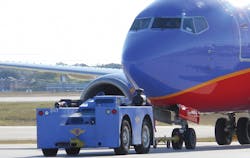A Misunderstood Risk From Constant Exposure To Aircraft Noise
For those working in noisy environments, hearing loss is a potentially serious problem. While hearing loss is perhaps the more common and better understood condition, tinnitus can also be very debilitating, leading to stress, anxiety or difficulty sleeping or concentrating.
Sufferers often complain of a “ringing in the ear.” No matter if it’s a ringing or buzzing or humming or roaring, the important distinction is that sufferers perceive sounds that are not actually present in the environment.
Many people have experienced this for a short time after exposure to loud sound – for example after attending a rock concert. Typically, this resolves on its own. But for those with chronic tinnitus, productivity and the overall quality of life can be diminished.
According to the Occupational Safety and Health Administration, about 30 million U.S. workers are exposed to occupational noise each year. OSHA requires hearing conservation programs for workers exposed to noise levels above 85 decibels – about the volume level of noisy traffic. Between 90 and 95 dB, hearing loss can occur, if noise exposure is sustained.
OSHA sets legal limits on noise exposure in the workplace. These limits are based on a worker's time weighted average over an eight-hour day. With noise, OSHA's permissible exposure limit (PEL) is 90 dB for all workers for an eight-hour day. The OSHA standard uses a 5 dB exchange rate. This means that when the noise level is increased by 5 dB, the amount of time a person can be exposed to a certain noise level to receive the same dose is cut in half.
The aviation environment is rife with sources of high-volume noise, including aircraft equipment power plants, jet efflux, propellers, rotors, pressurization systems and the aerodynamic interaction between ambient air and aircraft surfaces. Jet engines, for example, may generate sounds as high as 160 dB.
Most cases of tinnitus are related to damage to a person’s auditory system. This may or may not include subjective hearing loss. According to the American Tinnitus Association, many people commonly confuse tinnitus as being the cause or underlying condition. Hearing loss, however, is either conductive (problem with outer or middle ear) or sensorineural (problem with inner ear) and classified by different categories: mild, moderate, severe and profound.
COMPLEX PROCESS
Hearing loss is a complex process and due to the personal and unique nature of each tinnitus condition, proper evaluation and specialized treatment is necessary.
However, in many cases tinnitus accompanies hearing loss. Because hearing loss can be caused by noise damage to the ear, an individual can get both hearing loss and tinnitus from noise damage. However the two do not always occur together. There are many who have no measurable hearing loss but have tinnitus.
The best way to prevent tinnitus is by protecting your hearing. Continuous exposure to loud noise or even intermittent exposure to excessively loud bursts of sound can still cause auditory damage.
Options for hearing protection include off-the-shelf foam ear plugs or custom-made silicone ear plugs. These can be standard ear protectors that block as much sound as possible or ear plugs which typically contain a filter and are designed to block out all frequencies equally to provide protection while maintaining sound quality. A high-end option would be an electronic earplug that passes soft sounds unaltered, and compresses louder sounds into the safe range without distortion.
In addition, every aviation headset maker offers protection against noises encountered on the ramp. Most, for example, make headsets that counter noise by blocking out as much 30 dB.
Wearing hearing protection will obviously not only protect your hearing, but offer protection from tinnitus as well.
VARIOUS TREATMENTS
Many tinnitus sufferers are not aware that there are various treatments that can provide relief.
Anyone who does experience tinnitus should see a qualified audiologist. While primary physicians may be the first point of contact for seeking treatment, audiologists are better equipped to test and prescribe more advanced treatments for tinnitus. These doctors can conduct both hearing and tinnitus evaluations and recommend the best course of action.
Treatments can range from biofeedback to cochlear implants and from drug therapy to treatment for TMJ.
The most effective treatments address both the neural component of tinnitus (the brain activity associated with how we process sound) as well as the perceptual component (how bothersome the tinnitus sound is perceived to be). Sound therapy addresses both conditions. Sound therapy devices deliver tones that are frequency pitch matched and rapidly modulated to help tinnitus patients get relief.
While there is no definitive “cure” for tinnitus, research is ongoing and new treatments do occasionally become available.
Tinnitus is experienced differently from person to person. So no one type of treatment is likely to be equally effective for all. The best way to find relief is to see a professional, get an evaluation, and persist in finding a solution that works. And remember to always protect your hearing when in a noisy environment to prevent future auditory damage. The American Tinnitus Association (www.ata.org) is an excellent source of information as well.
About the author: Jeff Carroll, Ph.D. is director of clinical services and engineering for Sound Cure, Inc., a sound therapy system. He was the founding Director of the Tinnitus Treatment Center at the University of California, Irvine, and has worked with hundreds of tinnitus patients over the past decade. Dr. Carroll holds a doctoral degree in Biomedical Engineering from UC-Irvine.







